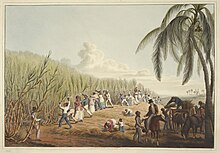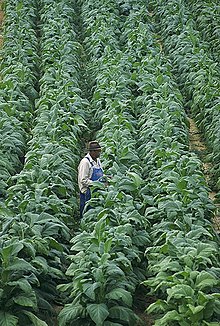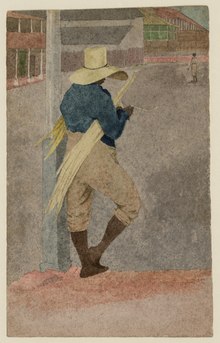Slave plantation
This articleneeds additional citations forverification.(August 2023) |
Aslave plantationwas an agricultural farm that used enslaved people for labour. The practice was abolished in most places during the 19th century.
Slavery
[edit]
Plantersembraced the use ofslavesmainly becauseindentured laborbecame expensive. Someindentured servantswere also leaving to start their farms as land was widely available. Colonists in the Americas tried usingNative Americansfor labor, but they were susceptible to European diseases anddied in large numbers.The plantation owners then turned to enslavedAfricansfor labor. In 1665, there were fewer than 500 Africans inVirginiabut by 1750, 85 percent of the 235,000 slaves in theThirteen Colonieslived in the southern colonies, Virginia included. Africans made up 40 percent of the South's population.[1][page needed]
According to the1840 United States Census,one out of every four families in Virginia owned slaves. There were over 100 plantation-owners who owned over 100 slaves.[2]The number of slaves in the 15 States was just shy of 4 million in a total population of 12.4 million and the percentage was 32% of the population.
- Number of slaves in the Lower South: 2,312,352 (47% of total population) 4,919 million.
- Number of slaves in the Upper South: 1,208,758 (29% of total population) 4,165 million.
- Number of slaves in the Border States: 432,586 (13% of total population) 3,323 million.
Fewer than one-third of Southern U.S. families owned slaves at the peak of slavery prior to the outbreak of theAmerican Civil Warin 1861. InMississippiandSouth Carolina,the figure approached one-half. The total number of slave owners was 385,000 (including, inLouisiana,somefree African Americans), amounting to approximately 3.8% of the Southern andBorder statespopulation.

On a plantation with more than 100 slaves, the capital value of the slaves was greater than the capital value of the land and farming implements.
Slave-poweredlatifundiafeatured in the economy of territories ofclassical Romefrom the 2nd century BCE. The first slave plantations in the New World originated in the Caribbean islands, particularly in the West Indies on the island ofHispaniola,where Spaniards introduced the system in the early 16th century CE. The plantation system, based on slave labor, was marked by inhumane methods of exploitation. After being established in the Caribbean islands, the plantation system spread during the 16th, 17th, and 18th centuries toEuropean colonies in the AmericasandAsia.All the plantation systems had a form of slavery in their establishment: slaves were initially forced to be laborers in the plantation system; these slaves were primarily native Indians, but the system was later extended to include slaves shipped from Africa. Indeed, the progress of the plantation system was accompanied by the rapid growth of theslave trade.
The plantation system peaked in the first half of the 18th century,[citation needed]but later on, during the middle of 19th century, there was a significant increase in demand for cotton from European countries, which led to the expansion of the plantation system in the southern parts of United States. This made the plantation system reach a profound crisis,[citation needed]until it changed from depending on forced slave labour to employing mainly low-paid wage laborers with a smaller proportion of forced labour. In the late-19th century,monopoliesensured high profits from the sale of plantation products by exploiting cheap labourers, forced recruitment, peonage and debt servitude in Asia, Africa, and Latin America.[3]
The new-fangledfactoriesof theindustrial revolutionadopted some of themanagementpractices of the slave plantations in order to organise and control their growingworkforces.[4]
Atlantic slave trade
[edit]Enslaved Africans were brought from Africa by European slave traders to the Americas. They were shipped fromportsinWest Africato European colonies in the Americas. The journey from Africa across the Atlantic Ocean was called "themiddle passage",and was one of the three legs which comprised thetriangular tradeamong the continents ofEurope,theAmericas,andAfrica.
By some estimates, it is said that some ten millionAfricanswere brought to the Americas. Only about 6% ended up in the North American colonies, while the majority were taken to theCaribbeancolonies andSouth America.A reason many did not make it to the colonies at all was disease and illness. Underneath the slave ship's decks, Africans were held chest-to-chest and could not do much moving. There was waste and urine throughout the hold; this caused the captives to get sick and die from illnesses that could not be cured.[5]
As the plantation economy expanded, the slave trade grew to meet the growing demand for labor.[6]
Industrial Revolution in Europe
[edit]Western Europewas the final destination for the plantation produce. At this time, Europe was starting toindustrialize,and it needed a lot of materials to manufacture goods. Being the power center of the world at the time, they exploited the New World and Africa to industrialize. Africa supplied slaves for the plantations; the New World producedraw materialsfor industries in Europe. Manufactured goods, of higher value, were then sold both to Africa and the New World. The system was largely run by European merchants[7]
Sugar plantations
[edit]
Sugarhas along historyas a plantation crop. Cultivation of sugar had to follow a precisescientific systemto profit from the production. Sugar plantations everywhere were disproportionate consumers of labor, often enslaved, because of the high mortality of the plantation laborers. In Brazil, plantations were calledcasas grandesand suffered from similar issues.
Theslavesworking the sugar plantation were caught in an unceasing rhythm of arduous labor year after year.Sugarcaneis harvested about 18 months after planting and the plantations usually divided their land for efficiency. One plot was lyingfallow,one plot was growing cane, and the final plot was being harvested. During the December–Mayrainy season,slaves planted,fertilizedwith animal dung, andweeded.From January to June, they harvested the cane by chopping the plants off close to the ground, stripping the leaves and then cutting them into shorter strips to be bundled off to be sent to thesugar cane mill.
In the mill, the cane was crushed using a three-roller mill. The juice from the crushing of the cane was then boiled or clarified until itcrystallizedinto sugar. Some plantations also went a step further anddistilledthemolasses,the liquid left after the sugar is boiled or clarified, to makerum.The sugar was then shipped back toEurope.For the slave laborer, the routine started all over again.
With the 19th-centuryabolition of slavery,plantations continued to grow sugar cane, butsugar beets,which can be grown intemperate climates,increased their share of the sugar market.
Indigo plantations
[edit]This sectionneeds expansionwith: Adding information about Indigo cultivation during 1850s and Nil Bidroha. You can help byadding to it.(August 2023) |
Indigoferawas a major crop cultivated during the 18th century, inVenezuela,Guatemala—andHaitiuntil the slaverebellion against Francethat left themembargoedby Europe andIndiain the 19th and 20th centuries. The indigo crop was grown for making blueindigo dyein the pre-industrial age.
Mahatma Gandhi's investigation of indigo workers' claims of exploitation led to the passage of theChamparanAgrarian Bill in 1917 by theGovernment of India.
See also
[edit]References
[edit]- ^The Southern Colonies: Plantations and Slavery
- ^"PBS The Slaves' Story".PBS.Retrieved2006-03-24.
- ^ T. K. Pazhitnova: "Plantation System".The Great Soviet Encyclopedia,3rd Edition (1970-1979). Retrieved fromhttps://encyclopedia2.thefreedictionary.com/PlantationSystem - "In the late 19th century the plantation system in the colonies and dependent countries became a profitable sphere for monopoly capital investment. Plantations owned by foreign monopolies were developed in Asia and Latin America, and the plantation system was widely introduced by monopoly capital in Africa. Cheap labor and broad opportunities for the application of precapitalist methods of exploitation (forced recruitment, peonage, and debt servitude) guaranteed the monopolies high profits from the sale of plantation products on the world market."
- ^
Karsten, Luchien (2013).Globalization and Time.London: Routledge.ISBN9781136300349.Retrieved26 March2023.
The modern factory system[:] Traditionally, the first American management practices originated in the cotton plantations where slave overseers, and slave drivers became 'the first large group of managers in American private enterprises. Cotton plantations presented a managerial challenge and brought into being America's first significant body of management writing, mainly by the slave owners' [...]. [...] Next to the former slavery practices on the large cotton plantations and the influence of engineers from West Point in the exploitation of railroad companies, there was another source to the development of modern American management practices. Traditional metalworking industries had created a systematic management movement [...].
- ^Stephen Behrendt (1999). "Transatlantic Slave Trade". Africana: The Encyclopedia of the African and African American Experience
- ^"How Slavery Helped Build a World Economy".National Geographic News.2003-01-03. Archived fromthe originalon August 8, 2019.Retrieved2020-04-22.
- ^The Abolition Project,http://abolition.e2bn.org/slavery_42.html,accessed 3-26-2013
